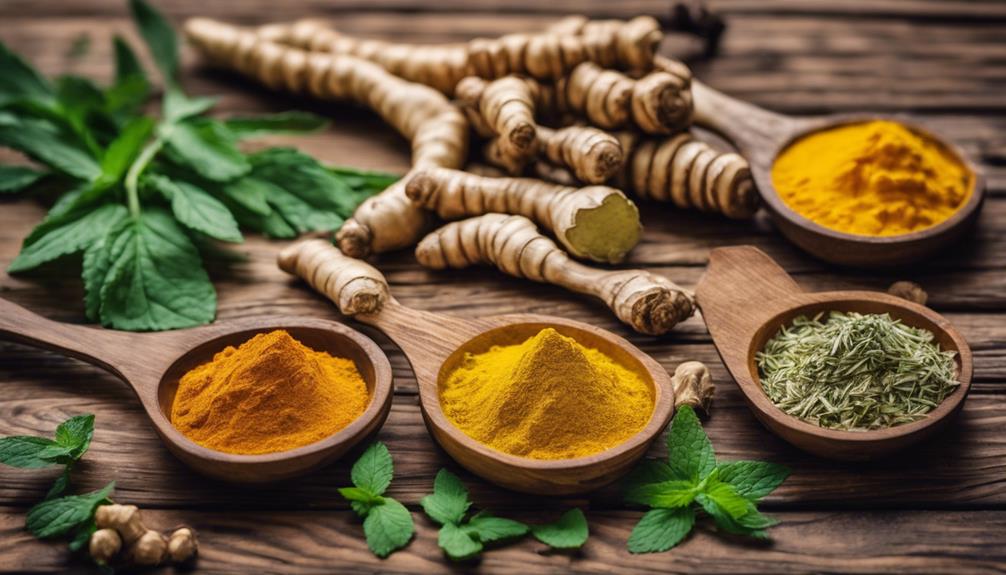Herbal patches and plasters have a long history of traditional use for pain relief across cultures, combining natural herbs like arnica, ginger, turmeric, and menthol to soothe muscles and joints. They work by delivering active ingredients directly through your skin, providing localized relief and reducing inflammation with fewer side effects than pills. Modern innovations enhance their efficiency, making them a safe, convenient option. Continue exploring to learn how these natural remedies fit into today’s holistic pain management strategies.
Key Takeaways
- Herbal patches and plasters have ancient roots in traditional medicine, offering natural pain relief across cultures like Chinese and Native American practices.
- They contain herbs such as arnica, ginger, turmeric, and menthol, formulated to maximize absorption and therapeutic synergy.
- These topical remedies deliver active compounds directly to tissues, providing localized, sustained relief with fewer side effects than synthetic drugs.
- Compared to pills, herbal patches offer steady release and lower risks of gastrointestinal issues and dependency, making them safer for long-term use.
- Advances like nanotechnology and personalized formulations are shaping the future of herbal patches for more effective, safe pain management today.
The Historical Roots of Herbal Patches and Plasters

Throughout history, herbal patches and plasters have been used across cultures as a simple, effective way to deliver medicinal benefits. Ancient civilizations, like the Chinese and Egyptians, recognized the power of topical herbal applications for healing. They applied crushed herbs or poultices directly to the skin, believing it helped target pain and promote healing. In traditional Chinese medicine, herbal plasters became popular for their ability to provide continuous relief without oral medication. Similarly, indigenous peoples in the Americas used plant-based patches for various ailments. Over centuries, these methods evolved into more refined forms, but the core idea remained the same: delivering herbal medicine directly through the skin for faster, localized relief. This long history underscores the enduring value of topical herbal remedies.
Key Herbs Used in Traditional Formulations

You’ll find that certain herbs are favorites for their pain-relieving properties, like ginger and turmeric. Understanding the herbal formulation techniques helps you see how these ingredients are combined for maximum effectiveness. By exploring these key herbs and methods, you can better appreciate their role in traditional remedies.
Common Pain-Relieving Herbs
Several herbs have long been valued for their ability to relieve pain when applied via patches or plasters. These herbal remedies have been used across cultures for centuries, offering natural relief without harsh chemicals. Here are some key herbs commonly used:
- Arnica – Known for reducing inflammation and swelling, arnica helps soothe muscle aches.
- Ginger – Its anti-inflammatory properties help alleviate joint and muscle pain.
- Turmeric – Containing curcumin, turmeric fights inflammation and improves circulation.
- Menthol – Provides a cooling sensation that temporarily blocks pain signals.
These herbs are often incorporated into traditional formulations, offering targeted relief and supporting natural healing processes. They form the core of many herbal patches and plasters designed to ease pain effectively.
Herbal Formulation Techniques
Herbal formulation techniques combine traditional knowledge with practical methods to create effective pain-relief patches and plasters. You select key herbs known for their soothing and anti-inflammatory properties, such as turmeric, ginger, and arnica. These herbs are often processed into powders, extracts, or pastes, guaranteeing their active compounds remain potent. You then incorporate them into a suitable carrier, like a herbal adhesive or a bio-compatible sheet, to facilitate absorption through the skin. Careful attention is given to the proportions and combinations of herbs to maximize their synergy. This meticulous process ensures the herbal patch delivers targeted relief while minimizing irritation. By blending tradition with science, you craft formulations that harness the healing power of herbs effectively and safely.
How Herbal Patches and Plasters Work to Relieve Pain

Herbal patches and plasters work by delivering natural ingredients directly through the skin, targeting pain at its source. Once applied, active compounds are absorbed into underlying tissues, providing localized relief. These patches often contain herbs with anti-inflammatory, analgesic, or soothing properties that penetrate deep into muscles and nerves.
Here’s how they work:
- Absorption: The skin absorbs herbal compounds gradually for sustained relief.
- Targeting: Ingredients reach specific pain areas, reducing inflammation and muscle tension.
- Modulation: Natural compounds interact with nerve receptors, decreasing pain signals.
- Circulation: Enhanced blood flow helps remove inflammatory substances, promoting healing.
This direct approach makes herbal patches effective for quick, targeted pain relief without systemic side effects.
Benefits of Using Natural Remedies for Discomfort

Using natural remedies for discomfort offers a gentle yet effective way to manage pain without the risks associated with synthetic drugs. You benefit from fewer side effects and reduced dependency, making these options safer for long-term use. Natural remedies often contain ingredients with anti-inflammatory and soothing properties, helping to target pain at its source. They are generally accessible and affordable, allowing you to take control of your comfort without frequent visits to the doctor. Additionally, many people find that herbal patches and plasters provide a non-invasive and convenient alternative to pills or injections. By choosing natural remedies, you support your body’s healing processes while avoiding harsh chemicals, making your pain management more aligned with holistic health principles.
Modern Innovations in Herbal Patch Technology

Modern herbal patch technology features advanced delivery systems that enhance absorption and effectiveness. Researchers are also developing custom formulations tailored to specific needs, making treatments more targeted. These innovations are transforming how you experience natural relief through herbal patches.
Advanced Delivery Systems
Advancements in delivery technology have revolutionized herbal patches and plasters, making them more effective and user-friendly. Modern innovations enhance how active ingredients penetrate your skin, ensuring better absorption and faster relief. These systems utilize cutting-edge methods such as microencapsulation, bioadhesive layers, and controlled-release matrices.
Here are four key innovations:
- Microencapsulation, which protects herbs and controls release rates.
- Bioadhesive layers that improve adhesion and increase contact time.
- Controlled-release matrices that sustain herbal delivery over extended periods.
- Nanotechnology, which facilitates deeper skin penetration for faster relief.
These advancements optimize delivery, increase efficacy, and improve your overall experience with herbal patches and plasters.
Custom Formulations Development
Innovations in herbal patch technology now enable the development of highly customized formulations tailored to specific needs. You can select precise combinations of herbs, extracts, and active compounds to target particular pain types or conditions. Modern techniques allow you to adjust ingredient ratios, ensuring peak efficacy and minimal side effects. By analyzing individual patient responses, you can create personalized patches that deliver the right dosage over the desired duration. This customization enhances therapeutic outcomes and improves patient satisfaction. Additionally, advanced formulation methods facilitate the incorporation of novel ingredients, expanding treatment options beyond traditional herbs. With these innovations, you’re empowered to develop highly effective, tailored herbal patches that meet unique needs, making pain management more precise, adaptable, and patient-centric.
Comparing Herbal Patches to Conventional Pain Relievers

Herbal patches and plasters offer a natural alternative to conventional pain relievers, appealing to those seeking fewer chemicals and side effects. Unlike pills, they deliver active herbs directly through the skin, providing targeted relief. This method often results in fewer systemic side effects and can be used alongside other treatments. However, herbal patches may vary in strength and consistency, making dosing less predictable than standardized medications. Additionally, herbal patches are usually best for localized pain, while conventional pain relievers can address more widespread discomfort. Here are some key differences:
- Speed of relief: Patches provide steady, sustained release; pills act faster.
- Side effects: Herbal patches tend to cause fewer gastrointestinal issues.
- Long-term use: Patches often have fewer risks of dependency.
- Effectiveness: Conventional pain relievers are typically more potent for intense pain.
Popular Types of Herbal Patches and Their Uses

You’ll find that popular herbal patches contain ingredients like menthol, capsicum, or arnica, each chosen for specific benefits. These compositions target common pains such as muscle soreness, joint discomfort, or inflammation. Understanding their ingredients helps you select the right patch for your needs.
Common Ingredient Compositions
Many popular herbal patches and plasters contain a blend of natural ingredients designed to target specific ailments. These ingredients are carefully selected for their therapeutic properties and ability to penetrate the skin effectively. Common components include:
- Capsaicin – Derived from chili peppers, it helps reduce pain by depleting substance P, a pain mediator.
- Menthol – Provides a cooling sensation that temporarily relieves discomfort and improves blood flow.
- Camphor – Acts as a counterirritant, alleviating pain and inflammation.
- Arnica – Known for its anti-inflammatory and swelling-reducing effects, especially in muscular pain.
Together, these ingredients work synergistically to deliver targeted relief, making herbal patches versatile and effective for various discomforts.
Targeted Pain Relief
Different herbal patches are designed to target specific types of pain, providing focused relief where you need it most. For muscle soreness or joint pain, patches infused with menthol or eucalyptus offer cooling sensations that reduce inflammation and ease discomfort. If you’re dealing with nerve pain, patches containing capsaicin or arnica can help by desensitizing nerve endings and promoting circulation. For localized pain from injuries or sprains, herbal patches with turmeric or ginger deliver anti-inflammatory properties directly to the affected area. Some patches are formulated for deep tissue relief, while others focus on surface-level discomfort. Choosing the right type depends on your specific pain, but targeted patches deliver a focused approach, reducing the need for oral medication and providing quick, effective relief where it’s needed most.
Safety and Precautions When Using Herbal Remedies

While herbal patches and plasters can offer natural relief, it’s essential to prioritize safety and follow proper precautions. Always read the instructions carefully before use. Be aware of potential allergies by testing a small patch on your skin first. Avoid applying herbal remedies to broken or irritated skin to prevent adverse reactions. If you experience any discomfort, redness, or swelling, remove the patch immediately and consult a healthcare professional. Keep herbal patches out of reach of children and pets. Do not use herbal remedies if you’re pregnant or breastfeeding without medical advice. Here are key precautions:
- Test for allergic reactions beforehand
- Follow recommended application duration
- Avoid contact with eyes and mucous membranes
- Consult a healthcare provider if on medication
Trends and Future Directions in Herbal Pain Management

Advancements in herbal pain management are shaping a promising future, as researchers explore innovative formulations and delivery methods. You’ll see a growing focus on nanotechnology, which enhances the absorption and efficacy of herbal compounds through tiny delivery systems. Additionally, personalized medicine is gaining traction, allowing treatments tailored to individual genetic profiles and specific pain conditions. Researchers are also developing sustained-release patches that provide longer-lasting relief without frequent application. Natural extracts are being combined with modern pharmaceuticals to create hybrid therapies, merging traditional wisdom with scientific rigor. As consumer interest in natural remedies rises, expect increased regulation and standardization to ensure safety and consistency. These trends aim to make herbal pain relief more effective, accessible, and aligned with modern healthcare practices.
Incorporating Herbal Patches Into Holistic Health Practices

Incorporating herbal patches into holistic health practices offers a seamless way to enhance overall well-being by integrating traditional remedies with modern self-care routines. To maximize benefits, consider these approaches:
- Personalized Regimens: Tailor patch application based on individual health needs and specific pain points.
- Complementary Practices: Combine patches with meditation, herbal teas, or gentle exercises to promote relaxation and healing.
- Consistent Usage: Establish routine schedules to maintain steady herbal absorption and sustain relief.
- Holistic Monitoring: Track your responses and adjust patch types or durations for ideal results, ensuring your approach remains balanced and effective.
Frequently Asked Questions
Are Herbal Patches Suitable for All Age Groups?
Herbal patches aren’t suitable for all age groups, especially young children and the elderly. You should consult a healthcare professional before use, as some ingredients might cause allergies or adverse reactions. For children, gentler options are recommended, and the elderly should be cautious due to sensitive skin or medication interactions. Always read instructions carefully and monitor for any signs of irritation or discomfort when trying herbal patches.
How Long Do Herbal Patches Typically Stay Effective?
Herbal patches usually stay effective for 8 to 12 hours, like a gentle tide that gradually recedes. You might find that applying one in the morning keeps pain at bay throughout the day, but it’s best to follow the product’s instructions. Some patches are designed for longer wear, up to 24 hours. Always check the label to guarantee maximum relief without skin irritation.
Can Herbal Patches Cause Allergic Reactions?
Yes, herbal patches can cause allergic reactions. You might experience redness, itching, or swelling at the application site if you’re sensitive to certain ingredients. Always check the ingredients list before use and do a patch test on a small skin area first. If you notice any adverse reactions, remove the patch immediately and consult a healthcare professional. It is crucial to use herbal patches carefully to avoid potential allergic responses.
Are Herbal Patches Safe During Pregnancy or Breastfeeding?
Herbal patches are generally not recommended during pregnancy or breastfeeding because they could cause unexpected reactions or harm your baby. You might think they’re completely safe, but even natural ingredients can have potent effects. Always consult your healthcare provider before using any herbal patch during this time. Your health and your baby’s well-being are worth prioritizing over any quick fix, so play it safe and seek professional advice.
How Do Herbal Patches Compare Cost-Wise to Pharmaceuticals?
Herbal patches are generally more affordable than pharmaceuticals, especially over time. You might find that they cost less upfront and reduce your need for prescription medications. However, prices vary depending on the brand and ingredients. While herbal options can be budget-friendly, it’s important to take into account their effectiveness and consult with a healthcare provider to guarantee they suit your needs and don’t incur hidden costs.
Conclusion
So, while herbal patches may seem like a modern twist on ancient wisdom, they remind us that sometimes, nature’s remedies are the best kept secrets. You might think technology has all the answers, but a simple herbal plaster could still outsmart pain. Ironically, in a world obsessed with synthetic solutions, it’s the natural, time-tested remedies that might just provide real relief—without all the fuss. Sometimes, the old ways truly are the best ways.










